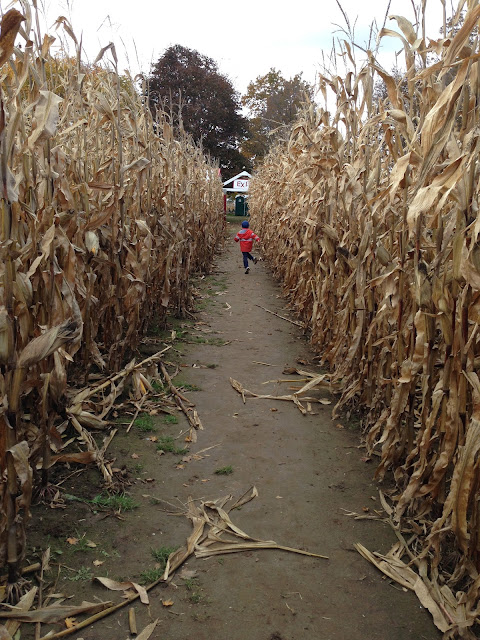“...the
corn rustled and whispered secretly. It was well pleased.”
“Children
of the Corn” by Stephen King
Fall is a magical time for the Toronto maze
enthusiast, as every year a bountiful crop of corn mazes arises around the GTA.
I try to do at least one annually, and this year we decided to visit the Hanes Corn Maze in Dundas.
The Hanes family has been creating corn
mazes for at least 15 years. Their maze, among the largest in Ontario, covers
20 acres and has a different theme each year. This year’s theme was bees. We
paid our admission and were handed a map of the maze, showing how the paths had been designed to represent a sun, honeycomb, bees, flowers and a butterfly. Off
we set and before long we were chasing one another down the long, branching
corridors of corn.
As with most corn mazes, the goal of the
Hanes Corn Maze is not just to find your way through from entrance to exit —
this task was almost trivial due to the layout — but to locate checkpoints throughout
the maze. These checkpoints have codes to help you solve a puzzle on your map, as
well as symbols to check off and factoids about bees and honey. Ten of the
seventeen checkpoints were marked on the map, and seven were hidden.
This was all very cute and fun but what you
realize once you enter the Hanes corn maze, and indeed any corn maze, is that
it is fundamentally terrifying to be in a mature cornfield. Part of it is that
it feels like you might really get lost and not be able to find your way out.
It happens — only last year a little girl wandered into the cornfield on her
family farm, and wasn’t found until the next day. (She was fine, but what a
night she must have spent.) At Hanes, you can use a few landmarks to help you
orient yourself, including the wooden bridge that lets you see the maze from a
higher vantage point, where it just looks like an enormous, gently waving sea
of gold. But often you feel hopelessly turned around and confused, unsure if
you’ve seen this fork or that curve before. It's the sameness and endlessness of the rows and rows of looming stalks. This is spooky enough during the day;
I can only imagine how this feeling must be magnified if you try the maze at
night. (“Bring your own flashlight,” says the website. I think I'd need a hip flask and a large, unflappable friend, as well.)
Trying to solve a corn maze can take on the
quality of a dream in which you run and run but never get anywhere, or in which
you keep coming back to the same place no matter where you turn. (We
intentionally enhanced this feeling of randomness and futility by letting the five-year-old
make the decisions instead of trying to read the map.)
There’s also something about the quiet that
is unsettling. There were a number of visitors to the maze when we went, but
once you’re inside, the maze is so large that you rarely encounter anyone, and
mostly all you hear is the cornstalks rustling as the wind blows through them,
which really does sound like whispering. You can get where Stephen King was
coming from.
Although we did not encounter any murderous children or red-eyed corn gods in the maze, we did find enough of the checkpoints to solve the riddle. I won’t spoil it in case you decide to go (the maze runs until November 14), but let’s just say it’s thematically consistent and involves a terrible pun. Mini–maze enthusiast was very pleased with his mini–Aero bar prize for getting the right answer.
While we were decoding the riddle, we talked with the young man helping to run the maze. Turns out he’s Hanes the younger and he filled us in on how the maze was made. Although we had read that these days, many people use GPS to plan and execute their designs — even hiring companies to do this for them — Hanes farm does things the old-fashioned way. Dad plants the corn, sowing in both directions so that when the corn is grown it will form opaque walls between the pathways. Next, Mom draws a design on graph paper so that each division on the paper corresponds to a row of corn. Once the corn starts to grow, they go out into the field with little flags and mark out the maze. The final step is to take a lawnmower to the growing corn to make the paths.
From design to finished maze, the process takes about two or three weeks. And then the corn has to grow to its full size, of course.
All the better to eat you alive.
by Sara Goodchild
See also Mazes and Labyrinths, Part I, Mazes and Labyrinths, Part II, and Mazes and Labyrinths, Part III.













looks creepy lol but I want to try this maze with dad haha
ReplyDelete